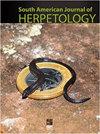Relationships of Brain Glucocorticoid Receptors and Commonly Used Stress Parameters with Body Condition of Juvenile American Alligators (Alligator mississippiensis)
IF 0.7
4区 生物学
Q4 ZOOLOGY
引用次数: 0
Abstract
Abstract. Crocodilians in aquacultural settings exhibit variations in growth and condition. The underlying cause of this has yet to be elucidated, but corticosterone (CORT, the main crocodilian stress hormone) is thought to play a role in this. In this study, we measured baseline plasma CORT, heterophil-lymphocyte (H/L) ratios, relative glucocorticoid receptor (GR) levels in the forebrain, and body condition index (BCI) of juvenile American alligators (Alligator mississippiensis). Both univariate and multivariate analyses were used to investigate underlying relationships. In univariate analysis, BCI was negatively related with GR levels, but not by plasma CORT. Multivariate analysis revealed that both relative forebrain GR levels and plasma CORT were negatively related with alligator BCI: alligators with higher body condition had lower levels of CORT and GRs. However, H/L ratios were unrelated to BCI. Our results implicate dysregulation of the hypothalamic-pituitary-adrenal axis as an important factor influencing crocodilian body condition.密西西比短吻鳄幼鳄脑糖皮质激素受体及常用应激参数与身体状况的关系
摘要在水产养殖环境中,鳄鱼在生长和条件上表现出差异。其潜在的原因尚未阐明,但皮质酮(CORT,主要的鳄鱼应激激素)被认为在其中发挥作用。在这项研究中,我们测量了美国短吻鳄(短吻鳄密西西比)幼鳄的基线血浆CORT、异嗜淋巴细胞(H/L)比率、前脑相对糖皮质激素受体(GR)水平和身体状况指数(BCI)。单变量和多变量分析均用于调查潜在关系。在单因素分析中,BCI与GR水平呈负相关,但与血浆CORT无关。多因素分析显示,相对前脑GR水平和血浆CORT水平与短吻鳄BCI呈负相关,身体状况越好短吻鳄的CORT和GRs水平越低。然而,H/L比率与BCI无关。我们的结果暗示下丘脑-垂体-肾上腺轴的失调是影响鳄鱼身体状况的重要因素。
本文章由计算机程序翻译,如有差异,请以英文原文为准。
求助全文
约1分钟内获得全文
求助全文
来源期刊
CiteScore
1.50
自引率
0.00%
发文量
10
期刊介绍:
The South American Journal of Herpetology (SAJH) is an international journal published by the Brazilian Society of Herpetology that aims to provide an effective medium of communication for the international herpetological community. SAJH publishes peer-reviewed original contributions on all subjects related to the biology of amphibians and reptiles, including descriptive, comparative, inferential, and experimental studies and taxa from anywhere in the world, as well as theoretical studies that explore principles and methods.

 求助内容:
求助内容: 应助结果提醒方式:
应助结果提醒方式:


